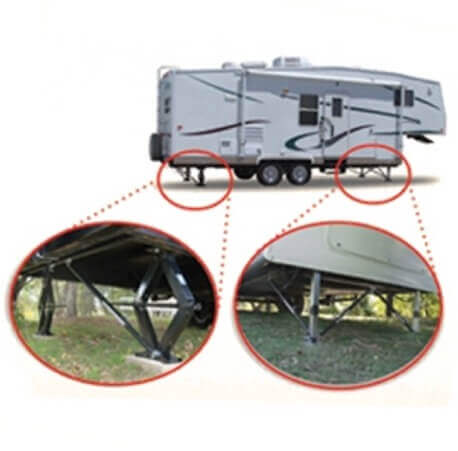 Keeping your RV level can be crucial, not only to your overall comfort, but to other factors as well. For example, if you have an absorption refrigerator, it needs to stay level while it’s running in order to work properly. Also, a coach that is not level can put additional stress and wear on the frame. How much you have to level your RV can depend on where you are. Campgrounds will most likely be more level than what you would find while boondocking.
Keeping your RV level can be crucial, not only to your overall comfort, but to other factors as well. For example, if you have an absorption refrigerator, it needs to stay level while it’s running in order to work properly. Also, a coach that is not level can put additional stress and wear on the frame. How much you have to level your RV can depend on where you are. Campgrounds will most likely be more level than what you would find while boondocking.
When leveling your RV, it will involve more than just dropping your jacks down, but it isn’t necessarily a complicated process. Driving your RV onto leveling blocks, like
Lynx Levelers, can help you figure out the distance for your leveling jacks. Other times, digging a small hole into the ground for the tire to sit in can help, so long as the weather stays dry. It is best to level your motorhome from side-to-side first, before leveling front-to-back. Always remember to operate the leveling jacks in pairs, rather than lifting one corner at a time, so you can avoid twisting your RV’s frame or putting unnecessary stress on it. Using bubble levels is still an easy way to find out if your rig is level. If your RV has slide outs, keep them retracted until you have leveled the RV. If you are leveling a trailer, the sides should be leveled first before unhitching your tow vehicle. The jacks should be sitting on a wide enough foot so that they don’t sink into the ground or into soft asphalt. If necessary, jack pads, such as the RV SnapPad, can be used as a permanent solution.
Most newer RVs come with leveling jacks, but in case it didn’t, or if you need to upgrade your jacks, there are a few things to keep in mind. Leveling jacks mainly come in two types, automatic or manual. Automatic hydraulic systems, such as
Bigfoot, are more expensive than manual jacks, but they are easier to use in that they can level your coach simply by pressing a button or flipping a switch. They do have a more involved installation process as well. Manual jacks can provide a cost-effective option that also has an easier installation. They will require more effort during the leveling process as you would have to lift them yourself. When buying new leveling jacks, bear in mind how much weight they’ll need to handle, as weight capacities can vary.
After the RV is level, then you can work on stabilizing it. The wheels should be chocked to keep them from shifting when people are moving around inside the RV. This would also be the time to deploy stabilizing jacks. It’s important not to confuse stabilizing jacks with leveling jacks.
Stabilizing jacks are not meant to lift the RV, but simply to provide extra support to make sure it remains still and so the weight of the RV is not resting completely on the tires and leveling jacks.
A wide variety of supplies to aid in the leveling process are available. This includes hydraulic systems, blocks, jack pads, and more.
The Importance of Keeping Your RV Level